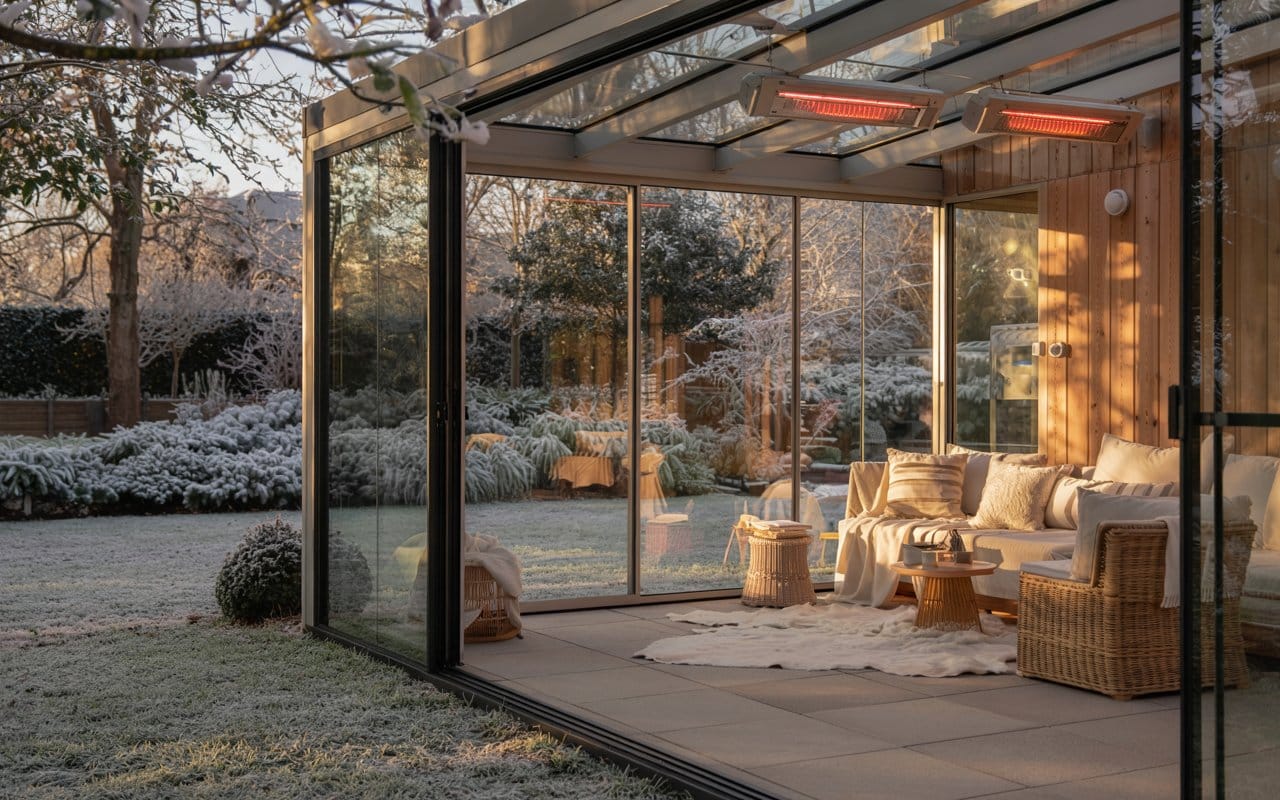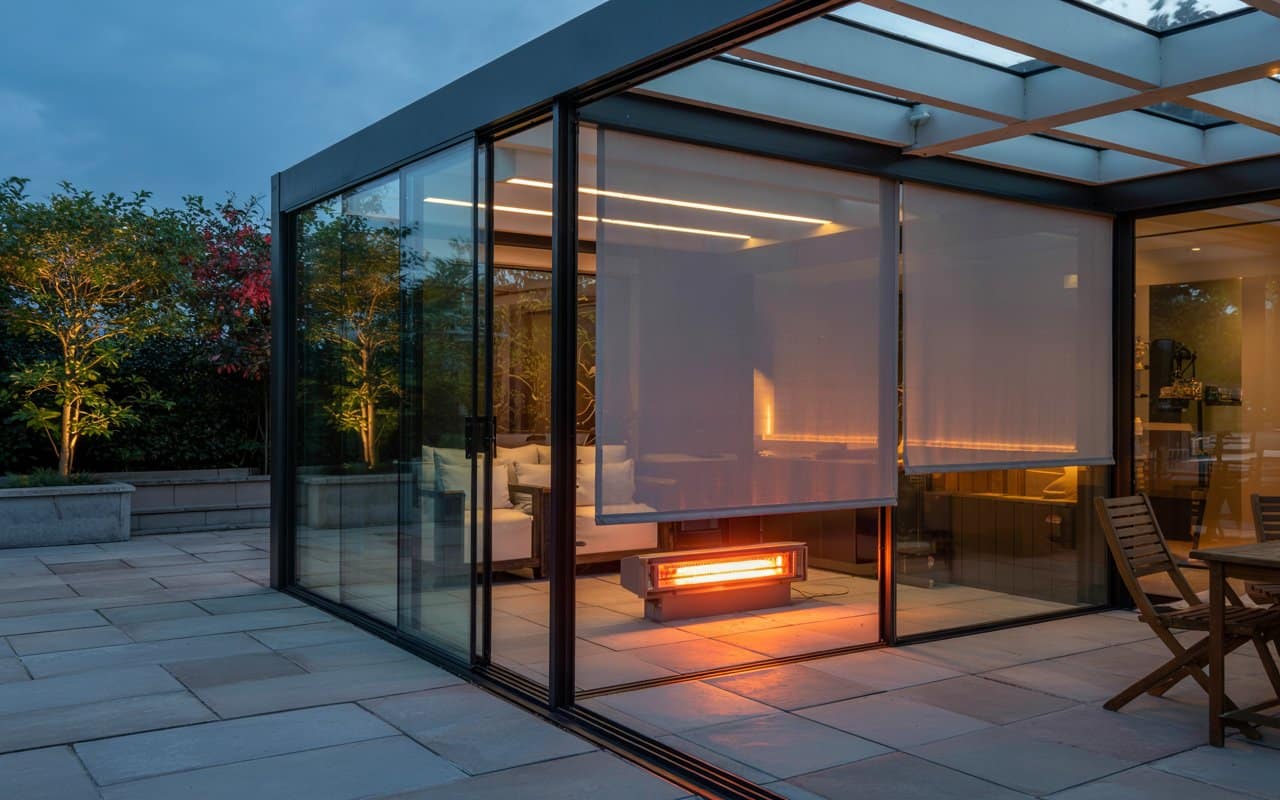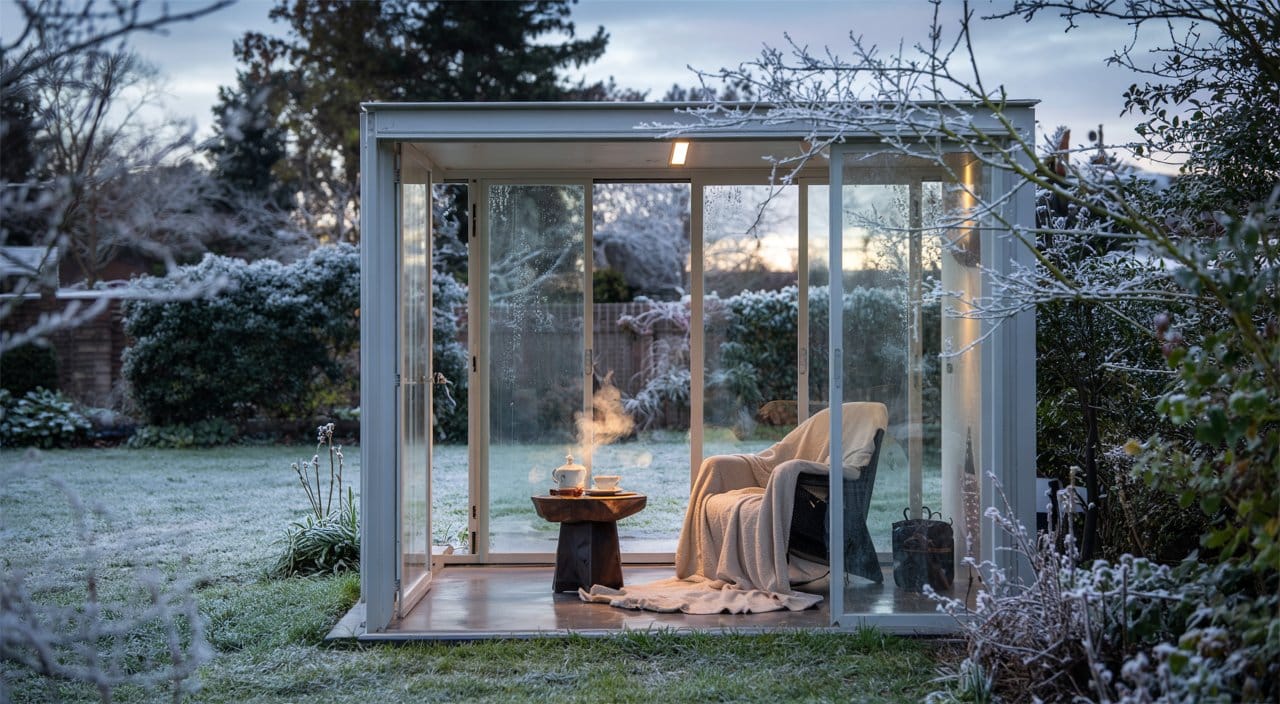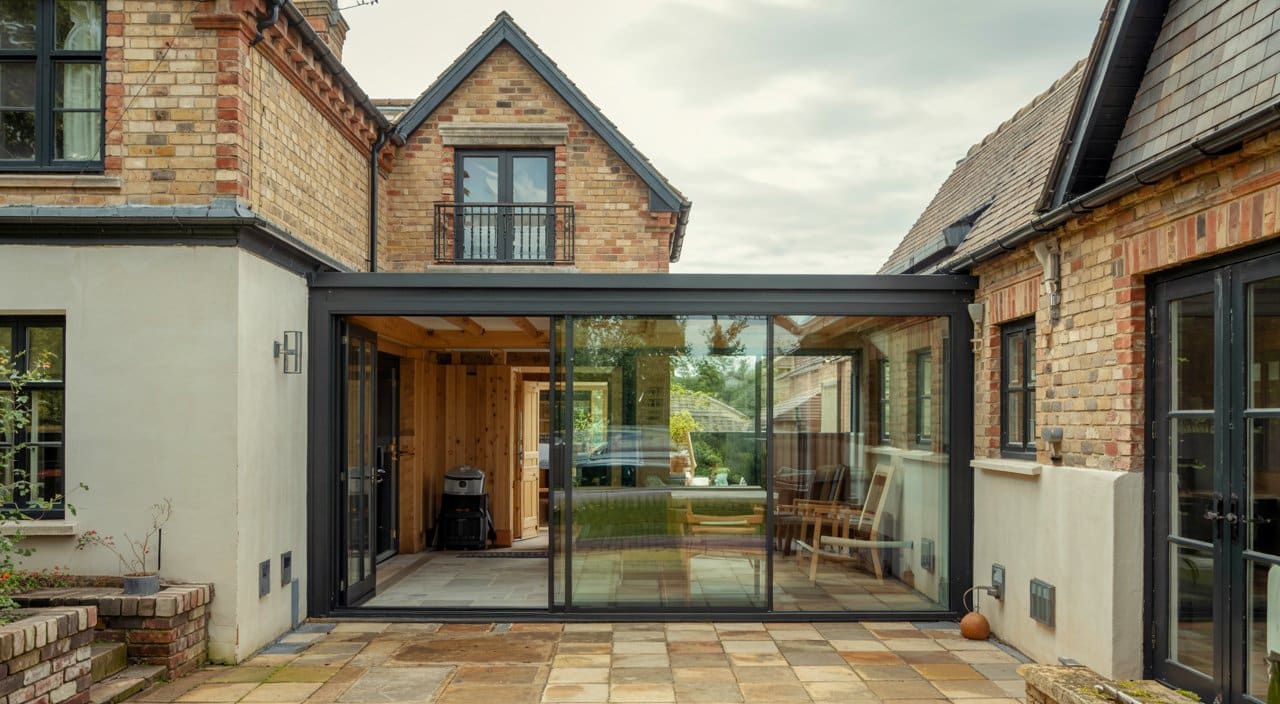Transforming Your Cold Glassroom into a Four-Season Sanctuary
The Unused Promise of Your Glassroom
Even the most visually striking glassroom can become a silent, underutilised zone as the year turns cold. You designed your space for bright mornings and firefly evenings, but too often, the cycle of chills, condensation, and rising heating costs claim it for half the calendar. The allure of seamless architecture blurs with reality: you watch the seasons from behind the main house windows, not within the luxurious space envisioned.
“It was perfect in autumn—then winter forced us back inside.”
Why Most Installations Fall Short in Winter
Every year, well-intentioned homeowners invest in glassrooms that fail to deliver comfort when it matters most. The disconnect is rarely due to taste; it’s the gap between visual intent and climate-tuned performance. Structural openness, beloved for its daylight, becomes a liability as thermal leaks and air fluctuations take over. When architectural dreams clash with harsh winds and thermal loss, even premium designs can induce regret rather than pride.
Upgrades That Turn Regret into Daily Benefit
Reclaiming your glassroom for all seasons involves foundational enhancements, not superficial fixes. Our approach weaves together aesthetic unity, structural precision, and targeted climate control—delivering a living space that performs as intended every month, providing both comfort and visual satisfaction.
- Invisible insulation: Preserve openness without heavy frames or clutter.
- Targeted heating: Adapt warmth to your usage patterns, not just outdoor temperature.
- Season-smart weatherproofing: Stop draughts and condensation at the perimeter without compromising sightlines.
- Soft CTA: Experience before & after transformations—imagine daily life uninterrupted by weather or wasted energy.
Diagnosing the Real Causes of Winter Discomfort
Where Comfort Is Lost
The experience of sitting in your glassroom, only to be forced out by a persistent chill, stems from a mix of hidden factors. These issues can be atomized into three domains:
- Thermal transfer: Single or even standard double glazing underperforms against British winters, rapidly losing warmth.
- Poor sealing: Micro-gaps at glass edges, joints, or doors allow cold air and damp to enter, even if invisible.
- Detail shortcuts: Non-specialist installations often leave under-addressed pressure points that widen over time.
Recognising the Signals of Inefficiency
You’re most likely to spot winter performance flaws in three scenarios:
- Condensation tracks along the edges after a cold night.
- Uneven warmth: Cold air pooling at ground level or near perimeter joints.
- Persistent draughts despite heat input, signalling leakage.
Table: Common Heat Loss Points & Their Impact
| Location | Symptom | Result |
|---|---|---|
| Glass-to-frame edge | Visible condensation | Cold zones, mould risk |
| Sliding door meets sill | Wind whistle/draught | Energy waste, discomfort |
| Roof-to-wall transitions | Drip or dew line | Insulation breach, stains |
Professional Audit vs. DIY Guesswork
Expert analysis goes beyond intuition, using thermal imagery and moisture detection at critical thresholds. By mapping exactly where energy escapes, we empower you to act surgically—targeting high-impact fixes rather than scattering effort or living with minor discomforts.
- Early CTA: Book your glassroom audit with us and know where every joule of heat is lost—turn guesswork into clarity.
Choosing Effective Insulation and Glazing Upgrades
The Spectrum of Modern Glazing Solutions
Glassrooms no longer mean a seasonal trade-off. Today’s advances allow you to select upgrades matched to your site, usage patterns, and design priorities.
- Low-E and triple glazing: Reflects heat inward, reduces radiant heat loss, and diminishes external chill.
- Warm-edge spacers: Break thermal bridges at the pane edge, eliminating “cold stripe” drafting.
- Frame upgrades: Multi-chamber, insulated frames and polyamide breaks operate invisibly under sleek exteriors.
Table: Measurable Gains from Insulation Options
| Upgrade | Typical Heat Loss Reduction | Secondary Benefits |
|---|---|---|
| Low-E triple glass | 35–55% | Maintains internal glass temp |
| Warm-edge spacer | 17–23% | Prevents local condensation |
| Insulated frames | 18–28% | Reduces exterior “cold spots” |
Matching Upgrade Choices to Your Goals
How much you invest depends on your property’s needs and the value of year-round access. For some, simply upgrading the glass solves persistent cold; for others, integrating heating and frame improvements offers a step change in outcome. The modular nature of modern solutions allows for phased implementation without cosmetic compromise.
“The room feels fundamentally different; even at dusk in January, there’s no race to pile on jumpers or plug in space heaters.”
- Configurator CTA: Contrast upgrade packages first-hand, seeing how each option improves energy, comfort, and style.
Preventing Draughts, Leaks, and Costly Condensation
Defeating the Perimeter Enemies
The most beautiful glassroom is undone by discomfort at the margins. Persistent draughts are not inevitable—they’re the result of overlooked details and lack of precision at the building’s edges.
Solutions That Preserve Aesthetic Purity
- Triple compression gaskets: Seal doors and sills without adding bulk.
- Interlocking seals: Create flexible, airtight junctions in high-movement areas.
- Moisture sensors: Detect leakage before it becomes an annual annoyance.
Drainage and Condensation: Invisible Risks, Lasting Damage
- Integrated perimeter drains: Subtly route away condensation to maintain cleanliness and stop mould.
- Flexible polymer barriers: Move with your building’s natural settling process, sealing anew as seasons change.
| Failure Mode | Preventive Solution | Outcome |
|---|---|---|
| Edge water ingress | Advanced drainage | Dry, stain-free sills |
| Persistent cold | Smart seal retrofitting | Even temperature, lower bills |
| Surface condensation | Humidity sensors | Timely warnings, reduced risk |
The Power of Maintenance and Aftercare
The Outdoor Living Group aligns aftercare not only with product warranties but also with local weather data, ensuring each upgrade continues to perform. Proactive maintenance—scheduled or on-demand—extends system life and forestalls the build-up of water, warping, or unseen draughts that degrade comfort over time.
“No more wiping up puddles by the French doors—just quiet, reliable comfort, season after season.”
- Soft CTA: Ask us about ongoing performance care, and prevent preventable repairs. Every glassroom deserves to age as gracefully as its design.
Integrating Smart Heating and Automation
Beyond Plug-In Heaters: The Benefits of Smart Integration
Your glassroom demands more than a knee-jerk response to cold weather. Instead of rotating through portable heaters or cranking manual thermostats, technological advances now allow climate adaptation to your lifestyle.
- Infrared radiant panels: Deliver immediate, focused warmth without airflow or noise.
- Programmable thermostats: Track your usage, adjusting temperature zones hour by hour, week by week.
- Integrated smart controls: Seamlessly blend lighting, heating, and even shading into one intuitive system.
“We set the room to 20° at 7 am—and it just happens, every day.”
Adapting Comfort to Real Usage
True comfort is achieved when your space responds automatically to your habits, not only to outside air. Zoned heating—differentiating needs during day and night, weekday and weekend—offers flexible, energy-efficient adaptations.
Table: Heating Integration and Smart Control Features
| Feature | Comfort Outcome | Energy Benefit |
|---|---|---|
| Radiant panels | Discreet, instant warmth | Targeted, reduced waste |
| Smart thermostats | Temp. adapts to occupancy | Lower bills, optimised cycles |
| One-touch controls | Simultaneous control of all systems | Effortless management |
- Mid CTA: Message our team to explore an automation path that matches your lifestyle and desired energy efficiency.
Balancing Ventilation, Freshness, and Insulation
Why Air Quality Matters as Much as Warmth
An impeccable seal is only part of the storey; trapped air soon becomes stale, and excess humidity breeds mould even in the warmest glassroom. The art is engineering just enough airflow—achieving comfort without sacrificing insulation.
Methods for Maintaining Healthy Winter Air
- Vented, flexible glass junctions: Allow strategic placement of controlled-air inlets.
- Remote-actuated roof vents: Enable discreet fresh-air cycles, even during storms.
- Humidity and CO₂ sensors: Offer continual checks for unseen risks.
| Ventilation Upgrade | Symptom Solved | Health/Comfort Impact |
|---|---|---|
| Auto-vent windows | Stale or stuffy air | Crisp, breathable indoors |
| Humidity sensors | Hidden mould, condensation | Healthy walls, no mustiness |
| Discreet air inlets | Over-sealing discomfort | Gentle, balanced climate |
“We noticed the difference inside a week—fresher mornings, no more window fog.”
- Soft CTA: Personalise your comfort by planning airflow and insulation as a unified system; get a seasonal air quality review with our team.
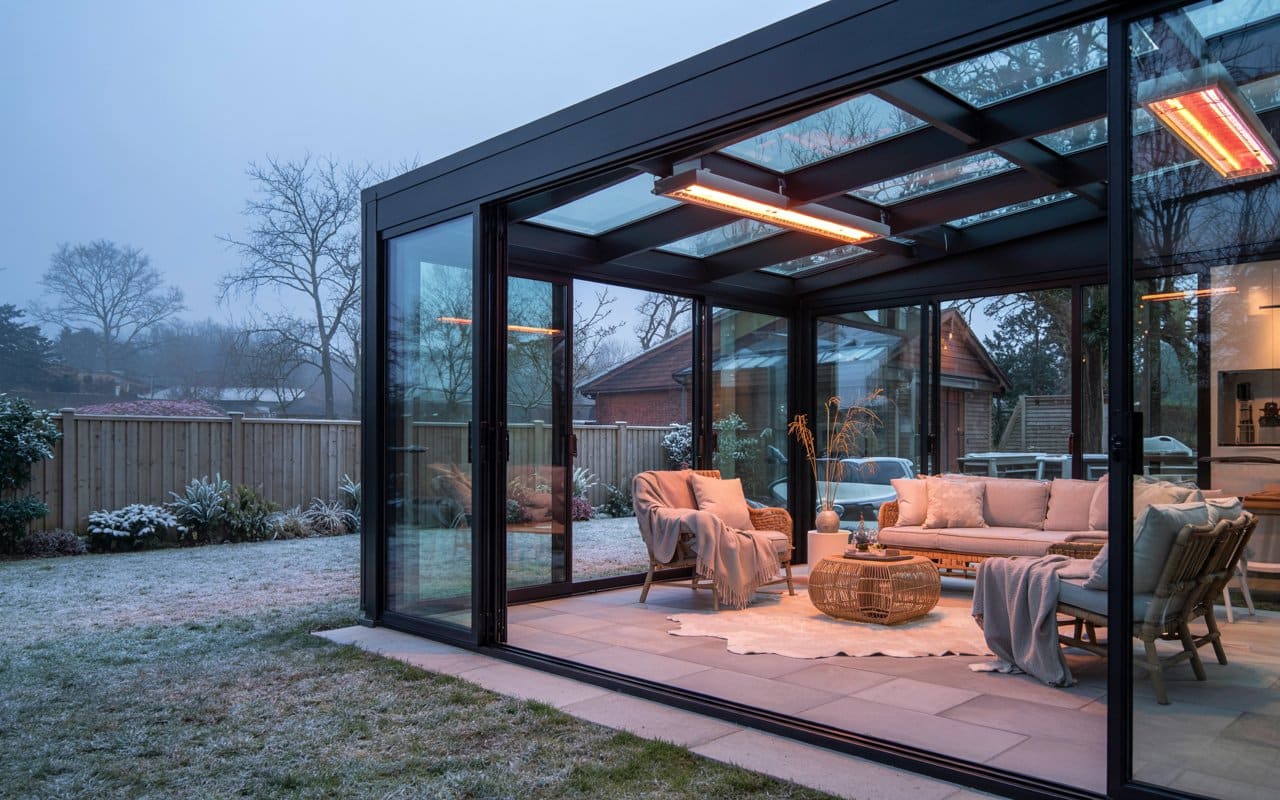
Retrofitting Without Sacrificing Design
Invisible Upgrades for the Design-Obsessed
Adding function need not dilute the visual purity you cherish. Modern enhancement technologies keep sightlines intact and finishes untouched, ensuring that every upgrade vanishes into the style it preserves.
Keys to Seamless Integration
- Flush-fit glazings: Replace old panes without visible stops or clips.
- Low-profile radiant heaters: Hide beneath frames or sills, imperceptible except for the comfort they provide.
- Palette-matched frames and blinds: Extend your interior design storey into every visible detail.
| Upgrade Type | Visual Impact | Comfort Gain |
|---|---|---|
| Flush glazing | None | High |
| Invisible frame sealing | None | Medium |
| Low-profile heating panels | Minimal | High |
| Palette-matched accessories | Cohesive look | Personal |
“It looked untouched—unless you noticed we weren’t wearing sweaters anymore.”
- Mid CTA: Let us show you style-meets-comfort outcomes; see colour, finish, and hidden tech that preserve a flawless aesthetic.
When to Seek a Professional Audit and Warranty-Driven Upgrade
Points Where Expertise Becomes Essential
Some issues—either hidden in structure or required by regulations—demand more than an enthusiastic DIYer. If you notice recurring condensation, persistent energy loss, or suspect a prior shortcut, engaging a certified team protects both comfort and compliance.
Events Triggering Audit or Upgrade
- Warranty expiry or coverage review: Uncovered issues must be solved with certified upgrades to preserve or renew coverage.
- Building standard modifications: Upgrading to meet changing fire, load, or ventilation codes is non-negotiable.
- System integration failures: If older or third-party components fail to play nicely, expert harmonisation saves time and repairs.
| Professional Step | Outcome | Required By |
|---|---|---|
| Thermal/structural audit | Clear problem diagnosis | Warranty stipulation |
| Compliance upgrade | Legal and insurer approval | Law/contract |
| Certified system upgrades | Coverage continuity, value up | Your asset protection |
“We nearly missed the renewal—until the audit revealed the silent cold breach in two joints.”
- Final CTA: Book a certified assessment with The Outdoor Living Group to move your glassroom into a lifetime of legal, seamless comfort.
Frequently Asked Questions
Contact The Outdoor Living Group for Transformational Results
Nothing replaces the impact of a home that transitions through every season without disruption. The difference between a glassroom avoided in winter and one that anchors family gatherings all year is never one of taste, but of expertly integrated solutions. Our commitment sits at the intersection of aesthetic mastery, engineered certainty, and relentless aftercare—so you never wonder if next November will leave part of your home unused.
Discover how intelligent upgrades, maintenance-backed performance, and bespoke design transform daily life. Explore what your glassroom is capable of—with The Outdoor Living Group by your side.
Integrating Smart Heating and Connected Comfort Solutions
Moving Beyond Patchwork Warmth: The Era of Smart Comfort
The elegant minimalism of your glassroom demands more than improvised warmth to thrive in winter. When you rely on plug-in heaters or space-consuming radiators, comfort never quite blends into the design. It remains a visible afterthought—a compromise that devalues the sanctuary you’ve envisioned. The transition to true comfort is marked by a seamless interplay between aesthetics and intelligent, invisible climate technology.
“When we stopped trying to outsmart the cold and let the system do it, the whole space transformed.”
Modern radiant panels, precisely mounted within the ceiling or architectural breaks, send warmth to where it matters, right to the zones you use. Unlike old convection systems that waft heat only to chase it out the glass, radiant heating targets the people, pets, and furniture that make your glassroom a lived-in space. This isn’t about “more energy.” It’s about directed thermal comfort that you sense, not see. When combined with programmable thermostats, each zone can shape itself across your family’s unique patterns, automatically dropping temperatures when the sun pours in or gently raising warmth before anyone starts their morning coffee.
The Anatomy of Connected Climate Control
- Programmable climate zones: Define your glassroom by purpose—reading nook, dining corner, plant-filled retreat—with each area adapting differently to time of day or week.
- Unified control: Adjust heating, lighting, and shading in a single, intuitive interface. Consistency of experience means you never think twice about how things “should” feel.
- Responsive sensors: Smart thermostats and occupancy sensors predict your needs, syncing warmth and convenience as you move through your day.
| System Feature | Outcome | Energy Effect |
|---|---|---|
| Radiant panel heaters | Targeted, invisible warmth | No wasted airflow |
| Multi-zone smart thermostats | Customised comfort routines | Lower bills, less waste |
| Sensor-driven adaptation | Comfort that anticipates | Optimised for use |
When everything works in concert, you notice the absence of intervention. No more adjusting knobs or tuning dials as the weather swings outside; instead, every comfort detail aligns with your presence. You experience warmth that’s architectural, not accessory. Our glassroom clients often describe it as the moment their space finally “settled in”—a room where warmth is just a given, as certain as the view.
Ready to make warmth part of your architecture, not a battle? Discover how integrated heating can make your glassroom intuitive, efficient, and always inviting.
Ensuring Fresh Air and Healthy Winter Ventilation
Sealing In Comfort, Not Stale Air
The pursuit of ultimate insulation occasionally unearths a new challenge: the risk that fresh air gives way to a closed-loop of condensation and stagnancy. If you’ve ever noticed windows mist with every kettle boiled or felt an inexplicable heaviness entering your glassroom, you’re not alone. Optimising climate is never a matter of “seal it tighter.” It’s the subtle orchestration of ventilation, filtration, and humidity management that defines a healthy winter retreat.
“When winter finally set in, what we appreciated most was stepping in and breathing easy.”
Effective ventilation solutions in modern glassrooms focus on mechanically assisted airflow, stealthily placed to preserve design purity. Strategically integrated vents—roof-based or discreetly tucked at floor level—invite fresh air with precision, not draughts. Sophisticated humidity and CO₂ sensors discreetly monitor real-time conditions, activating airflow only as needed, ensuring your glassroom remains a refuge, not a microclimate of mould or fatigue.
Techniques That Preserve Air Quality
- Roof-integrated ventilators: Enable bursts of fresh air without disrupting insulation, quickly exchanging stale for revitalising.
- Humidity-responsive extraction: Sensors trigger extraction only when moisture levels demand, preventing over-drying or accidental cooling.
- Balanced fresh-air intake: Modulates inflow so neither fog nor chill ever find sanctuary.
| Ventilation Feature | Solves | Lifestyle Benefit |
|---|---|---|
| Roof actuated venting | Stale air | Light, invigorating space |
| Humidity-triggered sensors | Condensation | Protects finishes, no fog cleanup |
| Balanced intake/outflow | Over-sealing | Even, comfortable microclimate |
A truly optimised environment is measured not just by warmth but by how it feels to enter—how it’s always inviting, never stuffy, dank, or fatiguing. For those seeking healthy, comfortable winters, the key is not stopping every breath of outdoor air but letting it in at the right moment, and only in the right way.
Curious whether your glassroom’s air is enhancing comfort or quietly eroding it? Assess for invisible risks with our winter ventilation and air quality experts.
Aligning Upgrades with Building Regulations, Warranty, and Design Harmony
Comfort That’s Certified and Designed to Endure
Comfort isn’t a solo actor; it emerges from a team of systems—each upgrade needs to perform, harmonise, and, crucially, comply. When rules are ignored or shortcuts taken, the very upgrades designed to protect your glassroom can undermine its value, your coverage, and even your future sale. We see the subtle damage most: installations that look good, feel good, but sidestep a fire-resistance requirement, flout a ventilation directive, or compromise insurance eligibility. True expertise is not simply about fitting a radiant panel or weatherproof seal—it’s about knowing where compliance and design overlap, and letting neither slip.
“Not only did we get the warmth we’d missed—we had all the certification at hand for our records.”
How Compliance Secures Value and Peace of Mind
- Certified product specification: Only using Weinor-certified components means every detail—from thermal rating to wind load—is engineer-backed, code-verified, and approved.
- Documented installation: Paper trails aren’t bureaucracy—they’re your guarantee. Properly handled paperwork ensures claims, resale, and peace of mind, year after year.
- Warrantied integration: Certified teams magnify the value of each warranty, enabling seamless upgrades rather than undermining or voiding pre-existing coverage.
| Upgrade Factor | Why It Matters | Impact On Home/Asset |
|---|---|---|
| Certified hardware | Audit-safe, market-proven | Easily transfer resale value |
| Compliance reports | Smooths insurance/inspection | Quicker, safer transactions |
| Warranty links | No coverage void | Long-term reassurance |
The benefit? Upgrades that are invisible yet invaluable—systems you hardly notice but would truly miss if ever tested by audit, insurance claim, or market shift. Strong design is as much about documentation and compliance as it is about style and comfort. Our installations are not just approval boxes ticked; they’re a forward guarantee that value endures, no matter what tomorrow’s regulations or owners require.
Secure your glassroom’s comfort and status—schedule a compliance-focused upgrade audit, and give your property bulletproof assurance and beauty.
For a Free Design Consultation, Contact The Outdoor Living Group Today
Design-Led Comfort, Delivered Without Compromise
Your home and its ambitions deserve more than guesswork or short-lived upgrades. As winter encroaches, imagine not ceding your glassroom or veranda to cold, draughts, or dated technology, but instead pivoting it to centre stage—a space that’s always welcoming, effortlessly managed, and rewarded by its own resilience.
“Now the season’s schedule is ours again, not the weather’s.”
Flawless design requires trust, not only in product but in process. When our team joins your journey, you engage a legacy of certified engineering, relentless aftercare, and meticulous design-matching. We listen; every consultation is inspired by your home’s unique lines, your comfort priorities, and your desire for upgrades that quietly elevate both function and appearance.
Our process is simple and thorough. It begins with attentive listening, progresses through bespoke visualisations, and never pushes, prescribes, or rushes—a process that pays respect to both your investment and your imagination. When the time for decisions arrives, expect option clarity, lifecycle costings, and a focus on simplicity and style. You retain agency and certainty from concept to completion.
Your next step isn’t a leap; it’s a conversation grounded in empathy and expertise—a choice to enjoy your investment to the fullest, without seasonal constraints or second-guessing.
Book your no-pressure design consultation with The Outdoor Living Group and reimagine winter as the season your glassroom reaches its full potential.
What Should I Check Before Planning a Winter Retrofit?
Facing the Foundation: Diagnosing Your Glassroom’s Upgrade Potential
The anticipation of a serene, all-season glassroom often meets its first real challenge the moment you consider a winter retrofit. Before our specialists at The Outdoor Living Group fit your space with advanced climate solutions, the hard truth is clear: every upgrade’s promise is only as strong as the foundation it builds on.
Step 1: Frame Integrity and Glass Specification
Start by scrutinising the physical state of your glassroom. Examine your frame for subtle warping, expansion cracks, or any separation from corners where walls meet glass—signs that hint at underlying fatigue or poor previous repairs. Wood or metal, every material reacts differently to seasonal shifts. Warping, flexing under snow, or corroded fixings signal structural compromise, not simple wear.
Your glass specification is your next checkpoint. Not all installations support the weight or flexibility of enhanced sealing, triple-glazing, or replacement panels. Laminated panes fitted years ago might splinter when tensioned with modern gaskets. If you notice persistent condensation inside double-glazed units, water staining below joints, or brittle sealant, your glass could be a bottleneck for serious comfort upgrades.
Step 2: Visual Cues and Historical Clues
Conduct a room-wide scan for subtle red flags: – Distorted seals at door runners or the glass edge. – Fogging or moisture trapped within glass layers. – Watermarks beneath sills—any sign of standing water or stains, no matter how faint.
Verify installation paperwork. If you have missing load spec sheets or ambiguous glass certification, you face a high likelihood of retrofitting hurdles. Homeowners who inherited a glassroom may need expert load-testing before committing to upgrades.
“The comfort we hoped for was just out of reach—until a survey exposed the bridge leaks no one had seen.”
Step 3: Audit Readiness and Professional Evaluation
If you encounter concerns or can’t confirm past modifications, request an independent audit. Our retrofit teams regularly deploy non-invasive stress scanners and humidity tracking to expose what the eye misses. Detection of hidden flaws or legacy DIY mistakes can mean the difference between seamless transformation and a costly, drawn-out project.
Actionable Checklist: – Inspect for frame distortion, glass performance, and water ingress – Document or gather spec sheets from your installer – Flag warping, condensation, or leaks for deeper evaluation – If uncertain, schedule a full professional audit before planning upgrades
Address structural truth without compromise. When your foundation is ready, every other step becomes investment, not guesswork.
Why Does Condensation Appear and What Can I Do to Prevent It?
Unmasking the Enemies of Winter Comfort
Peering through a fogged glass panel as drops pool along the runner is the heart-sink for many glassroom owners in January. The science is stark: condensation is not a sign of bad luck—it’s a warning bell for design weakness or usage mismatch. At its root, condensation occurs when warm indoor air collides with a surface colder than the ambient dewpoint. For frameless or minimally framed glass structures, the battle is shaped by both climate and construction decisions.
Step 1: Identifying Humidity’s Hidden Pathways
Everyday life inside your space—cooking, indoor plants, even the steam from a mug—becomes airborne moisture, always seeking the shortest route to condensation. In glass-heavy design, the escape is usually straight to the nearest cold pane. Without ventilation or airflow, humidity spikes, fogging glass and feeding hidden mould colonies in peripheral materials.
Blocked or shallow drainage channels play their role by letting water linger, soaking insulation, or warping supports. Inadequate or unbalanced ventilation mismatches the intended ‘breathable’ design, converting the glassroom into a stagnant capsule.
“We tried leaving the windows cracked but it wasn’t enough. The stains kept coming back—the solution was deeper air control.”
Step 2: Practical Prevention and Lasting Technology
Remediation is part technical, part behavioural. Start with a seasonal clean of guttering and drains, paying attention to accumulating leaves or debris. For over-sealed rooms, periodic deliberate venting helps, but only if exterior air is drier than inside—and this balance veers wildly in British weather.
When basic fixes exhaust their use, our team at The Outdoor Living Group targets condensation at the infrastructure level: – Vented frames that invisibly draw fresh air from the base and exhaust stale air at the apex, supporting a full airflow loop. – Humidity and air quality sensors to monitor at-risk periods and activate extraction only as needed. – Hydrophobic glass treatments that make water slide cleanly, preserving clarity and resisting mould. – Upgraded perimeter drainage that guides even the harshest winter melt away from touchpoints where it can cause rot or cold bridging.
| Solution | Issue Prevented | Typical Upgrade Impact |
|---|---|---|
| Vented frames | Persistent condensation | Sustained clarity; less mop-up |
| Humidity sensors | Hidden mould | Air quality assurance |
| Drainage upgrades | Water pooling/staining | Prolongs material lifespan |
| Glass coatings | Fogging | Enhances look; lowers maintenance |
Condensation is relentless—only multi-layered countermeasures restore your glassroom’s transparency and habitability.
Where Should I Invest for the Best Winter Energy Savings?
Mapping ROI to Every Retrofit Decision
With every monthly bill or chilly step across a tiled floor, the need for intelligent energy investment sharpens. Not every upgrade yields the same return, and for meaningful comfort and meaningful savings, prioritisation is key.
Step 1: Choosing the Right Energy Anchor
Not all insulation performs equally, nor does every pane of glass hold warmth the same. Low-E triple-glazing and argon/krypton-filled units stand in front as runaway leaders in heat retention, reflecting infrared warmth inward and slashing radiative loss even as frost gathers outside.
Radiant panel heaters, a staple of our most successful energy overhauls, avoid the error of heating void space. Instead, they focus on the people using the room, delivering warmth with no wasted convection. Automated zone controls allow you to heat only when and where life happens—no endless “keep it on all day” expense.
When micro-leaks at the sills or meeting rails are left unchecked, sealed heat slips out and raw air slips in. Upgrading gaskets, multi-stage weatherstrips, and retrofitted edge seals might appear minor, but over a cold season, they guard against hundreds of lost kilowatt-hours.
“We worried about the look—then realised how much comfort and money we were losing. The right glass and hidden heating did more than any patchwork fix.”
Step 2: Prioritise Solution Order
For most glassroom retrofits: – Insulation always comes first: Seal leaks, shore up edges, then move to glass and heating. – Glazing is the greatest lever: It has the biggest impact on comfort and bills, justifying the cost. – Automation is the efficiency multiplier: Smart systems ensure you never forget to dial down at night or when empty; they “think” for you.
| Upgrade | Yearly Energy Savings (%) | Additional Value |
|---|---|---|
| Low-E glass | 30–45 | Property value, comfort |
| Panel heating | 10–25 | Precise warmth, air quality |
| Weatherstrips | 5–10 | Quiet, fewer draughts |
| Smart automation | 8–18 | Convenience, no guesswork |
Every step in this energy path builds on the last—modular, defensible results that deliver both comfort and a reduction in utility anxiety.
Can Style and Function Be Enhanced Together Through Discreet Upgrades?
Preserving Architectural Grace While Elevating Performance
The miracle of a modern glassroom lies in its ability to invite the outdoors in without surrendering comfort. Yet the fear of “bolt-on” fixes—visible heaters, chunky seals, glaring thermostats—stops many from upgrading. The new era of retrofit design takes these anxieties and renders them moot through seamless, invisible enhancement.
Step 1: Integration-First Technology
Comfort tech has matured into art. Flush-fit heater panels blend with ceiling or beam lines, emitting warmth with no clue to their presence. Ultra-slim, powder-coated gaskets nest inside original rails, vanishing into the silhouette of your architecture. Our team selects each element for design compatibility as much as technical prowess.
Step 2: Visual Consistency to the Last Detail
Eyes discern in millimetres. A radiant panel a shade off-white, a control switch with mismatched gloss—these betray the integrity of a deliberate space. We source or custom-tint every visible upgrade to meet the exacting standards of leading interior designers, ensuring harmony from room corners to rooflights.
Step 3: The Role of Smart Controls
Digital command does not mean obtrusive tech. Wall units discreetly installed at arm’s reach, or wireless modules linked to glass structure, give fingertip comfort without clashing aesthetics. The experience is “no touch, just warmth,” with mood-tuned light and air as subtle as the look.
| Upgrade | Discretion Level | Comfort/Control Benefit |
|---|---|---|
| Hidden heaters | Maximum | Zoned, silent warmth |
| Slimline gaskets | Maximum | Air/water seal |
| Palette-matched devices | Maximum | Design unity |
| Programmable smart units | High | Effortless adjustment |
“You’d never know we upgraded—until the first rainy morning we still lingered for coffee.”
Function and form are no longer adversaries. Our upgrades empower your glassroom to feel, look, and live as intended—without visible compromise.
Why Are Seals, Gaskets, and Drainage the Unsung Guardians of Comfort?
The Margins Where Winter Finds a Way In
A glassroom’s weakest points are nearly always its least noticed—until the first gust, first deluge, or frost makes its presence felt. Proper sealing is an almost invisible craft; it stops draughts, pooling, condensation, and damage before these become stories of lost investment.
Step 1: Profile the Perimeter
Scan each edge, from track to lintel, for gaps, loose fittings, or signs of historic tampering. If your room’s joints squeak or doors shift, wind stress may have warped the frames. Modern multi-lip seals are engineered to flex with shifting temperatures, always pressing closed, no matter the weather’s whim.
Step 2: Drainage Dictates Longevity
A water trail at breakfast may seem trivial, yet, beneath every escaped drop hides the risk of subsurface rot, mould, or frost heave. Perimeter, sub-track, and weep hole drainage channels should remain unclogged, sloped, and visually unbroken. For spaces new and old, we apply hydrophobic coatings and edge wraps—a silent but vital shield.
Step 3: Instal Monitored Protection
Our long-term clients value detection more than reaction. Small humidity or flood sensors, wired or wireless, offer pre-emptive warnings. They alert you—and our aftercare team—should unusual patterns arise, allowing intervention before emergency.
| Perimeter Solution | Risk Prevented | Durability Gain |
|---|---|---|
| Multi-lip weatherstrips | Cold air, rain entry | Year-round airtightness |
| Smart moisture sensors | Hidden leakage, flood | Lower repair rates |
| Hydrophobic edge treatment | Condensation, frost | Smoother glass surfaces |
“A spot of rust at the bottom of the track led to discovering a hidden leak that could have ruined our floor.”
Care for the small defences, and the comfort, beauty, and value of your glassroom scales with every season.
When Should I Call in a Professional (and What Role Do Rules Play)?
Beyond DIY: When Expertise and Compliance Are Non-Negotiable
There comes a threshold where tinkering fails. Complex instals, insurance standards, or evolving regulations demand more than a steady hand—they demand legal coverage, documented warranties, and a team that knows when to say, “We need to bring this up to code.”
Step 1: Trigger Events That Demand Expertise
- Visible condensation, recurring draughts, or persistent leaks.
- Unusual floor or frame movement after weather swings.
- Knowledge that your system’s warranty is near expiry or voided by prior, casual fixes.
Step 2: Regulatory Drivers
Ventilation, drainage, heating, or safety interventions may fall under local or UK building codes, often requiring assessment, sign-off, or specific upgrade types. These aren’t bureaucratic headaches—they’re shields for your investment, your peace of mind, and resale.
Step 3: The Audit and Documentation Process
Every certified improvement from The Outdoor Living Group comes with a clear audit trail—material certifications, before/after visuals, compliance confirmation, and new warranty endpoints. When passed to insurance, resale, or service, these documents are the passport for your room’s future.
| Trigger Event | Expert Solution | Outcome |
|---|---|---|
| Condensation/leakage | Full perimeter review | Fault found, cause addressed |
| Floor/frame movement | Compliance upgrade | Structural confidence restored |
| Warranty expiry, new law | Re-spec, document | Long lifespan, legal comfort |
“That audit saved us from disaster. The certificate made our buyer as confident as we were.”
Expertise and evidence are the backbone of comfort, resale, and reliability; shortcuts are the silent thieves of both.
For a Free Design Consultation, Contact The Outdoor Living Group Today
The Invitation to Transformative Comfort
There’s a moment when desire shifts from mere comfort to control—a vision of a home where architecture and technology collaborate. Preparing your glassroom for winter is more than a to-do; it’s a decisive gesture toward living fully in every season.
Our promise: We listen as precisely as we design. Every consultation with The Outdoor Living Group honours the individuality of your property, your style, and your seasons. No formula, no “one size fits all”—only the careful, attuned partnership that moves you from persistent frustration to delight.
“We were tired of searching for a fix—now we’re enjoying our space in the quietest months.”
Every barrier can be overcome. Start your journey where clarity replaces confusion and confidence replaces contingency. Book your no-pressure session today and see what a carefully advanced glassroom can be—even in the depths of winter.


